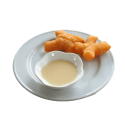What Is Trisodium Phosphate E339(iii) In Cereal? Uses, Safety, Side Effects

What is it | Production | Why it in cereal | Industrial uses | Safety | Side Effects | FAQs
Trisodium phosphate (TSP) or sodium phosphate tribasic, a common food grade ingredient used in cereal and other processed foods. The European food additive number for it is E339(iii). TSP can be used as an acidity regulator to decrease acidity in cereal, a moisture retainer to improve the tenderness (or juiciness) in meat and seafoods, and a supplement to enhance phosphorus nutrient in food.
What is trisodium phosphate?
It is an inorganic compound derived from naturally occurring minerals and existing mainly in two types: anhydrous with the chemical formula Na2HPO4 and dodecahydrate with chemical formula Na3PO4.12H2O.
How is it made?
Similar with monosodium phosphate and disodium phosphate, it is also commercially produced by the reaction of phosphoric acid with sodium carbonate or sodium hydroxide (commonly used for its higher PH than sodium carbonate), but with more of these alkalines until none of the protons (H+) from phosphoric acid left.
The following is the synthesis equation:
- 3Na2CO3+2H3PO4→2Na3PO4+3H2O+3CO2↑
- 3NaOH+H3PO4→Na3PO4+3H2O
A specific hydrate can be obtained by heat dodecahydrate to 55℃ – 65℃ to get decahydrate, heptahydrate (65℃ – 105℃), hemihydrate (100-212℃) and anhydrous (above 212℃).
Properties
Trisodium phosphate is a strong base and a weak acid salt, which has a high solubility in water and produces a strong alkaline solution.
Appearance
White odourless crystalline powder or granular.
Solubility
Freely soluble in water, insoluble in ethanol.
PH
11.5 to 12.5 (1% solution)
Melting point
Anhydrous: 1583°C
Other Names
- Sodium phosphate
- Tribasic sodium phosphate
- Trisodium orthophosphate
CAS Number
- 7601-54-9 (anhydrous)
- 10101-89-0 (dodecahydrate)
Chemical formula
- Anhydrous: Na3PO4
- Hydrated: Na3PO4.nH2O (n = 1/2, 1, 6, 8, or 12)
Molecular Weight
163.94 (anhydrous)
What are the uses of TSP?
In food, like other phosphates, food grade trisodium phosphate is used to keep moisture and maintain the flavor in seafoods, meat and poultry products and therefore increase the shelf life. TSP can hold moisture of food because its own basicity can increase the pH and ionic strength of food.
It can also function as a sequestrant to chelate metal ions in food. Its food grade is more purified, used with less amount than the technical grade which is mainly used as a cleaner and detergent. As a result, it is safer.
In cereal products, it is used to reduce acidity. TSP also acts as an emulsifier in pasteurized process cheese and cheese food, and an acidity regulator in fruit jellies, preserves, and jams (1).
Why is trisodium phosphate in cereal?
Commonly we can find its application in the ingredient list of breakfast cereal products, such as in cinnamon toast crunch (you’ll see TSP and other ingredients in it) and lucky charms of General Mills products.
General Mills responded in twitter that they put trisodium phosphate in cereal products to adjust the acidity when clients worry about the safety and think it is harmful as they mistaken it to the technical grade used as a cleaner and paint thinner.
TSP has other three functions in cereal products:
- Make cereal more creamy or yellow in appearance due to its high PH.
- Act as an antickaing agent to ensure the extruded cereal dry and free-flowing through extruder equipment.
- Fortifies phosphorus supplement.
Cosmetic
Per the “European Commission database for information on cosmetic substances and ingredients”, TSP functions as a buffering, and chelating in cosmetic and personal care products (2).
A mixture of food grade trisodium phosphate and baking soda can be used for homemade toothpaste/mouthwash as a mouth rinse after brushing teeth. Baking soda is a weak alkaline to adjust the alkaline of TSP mild.
Industrial
Technical grade trisodium phosphate is a very important phosphate in industrial uses, e.g. in chemical, textile, printing, dyeing, papermaking and power generation industries.
It has the advantages of convenient use and cheap price and commonly used as a
- Water softener
- Detergent
- Metal descaling agent
- Boiler cleaning agent
- Stain remover, mildew/mold remover
- Degreaser
- Acid-base buffer
Alkaline typically has a capacity to clean greases and oils. It sequestrates the metal ions such as calcium, magnesium, aluminum and iron in water to be insoluble phosphate precipitates, thereby removing them from the water.
It can work as a descaling agent and cleaning agent for metals because trisodium phosphate can enhance the wetting ability of water and has a certain penetration and emulsification effect, so it can effectively remove the dirt on the metal surface. In addition, TSP is often added to liquid household bleach for cleaning.
Is trisodium phosphate safe to eat?
Yes, its safety when used as a food additive has been approved by the U.S. Food and Drug Administration (FDA), European Food Safety Authority (EFSA), Joint FAO/WHO Expert Committee on Food Additives (JECFA), as well as other authorities.
FDA
Together with mono– disodium phosphate, they are generally recognized as safe (GRAS) when used in accordance with good manufacturing practice. (3)
EFSA
Trisodium phosphate E339(iii) is listed in Commission Regulation (EU) No 231/2012 as an authorised food additive and categorized as “additives other than colours and sweeteners” (4).
Safety re-evaluation in 2019
Phosphates will not contribute to genotoxicity, carcinogenicity, and developmental toxicity with appropriate uses level and EFSA derived a group acceptable daily intake (ADI) for phosphates expressed as phosphorus of 40 mg/kg body weight (bw) per day in 2019. (5)
Authorised uses and levels
Phosphates are permitted to use in almost all food categories and you may find the following foods with TSP (6):
- Sterilised and UHT milk
- Dried milk and dried skimmed milk
- Whipped cream
- Cheese
- Bread
- Meat with heat–treated or not
- Natural casings for sausages
- Infant formulae
- Cereals
- Frozen and deep-frozen fish products
UK Food Standards Agency
Categorized in “Others” (7)
Food Standards Australia New Zealand
It is an approved ingredient in Australia and New Zealand with the code number 339. (8)
JECFA
Function Class: food additives, acidity regulator, sequestrant, stabilizer. (9)
Tolerable Intake: MTDI 70 mg/kg bw (as P) set in 1982. (10)
What are the possible side effects?
Most consumers have concerns whether trisodium phosphate is bad for our health and what are the possible health risks, especially when they find this ingredient in the label of cereal products as most people refer it to a cleaner. It is generally considered safe but following two possible side effects may occur if too much of it:
- Too much phosphorus may be harmful to our kidney and heart.
- TSP is a strong alkaline, large doses may induce throat swelling, breathing difficulty, diarrhea, vomit, severe pain, and burning in the tongue, lips, nose, eyes.
Is it safe for pregnant?
Yes, it is generally safe but better consult with your doctor in the condition of use.
Frequently asked questions
Is it natural?
No, it is synthetic as it comes from chemical synthesis.
Is it vegan?
Yes, it is vegan as the raw materials phosphoric acid is from phosphate rocks, sodium carbonate is from the synthesis of sodium chloride and limestone, and sodium hydroxide is obtained from chemical synthesis instead of animal-derived. So it is vegan and suitable to add in the diet of vegetarians.
Is it Halal?
Yes, it is generally recognised as halal as it is permitted under the Islamic Law and fulfill the conditions of Halal. And we can find some manufacturers certificated with halal.
Is it Kosher?
Yes, it is kosher pareve. E339(iii) has met all the “kashruth” requirements and can be certified as kosher.
Is it gluten free?
Yes, it is typically gluten-free and people with celiacs can eat it. The manufacturing process complies with the FDA’s definition of gluten free, that it does not contain wheat, rye, barley, or crossbreeds of these grains.
Is trisodium phosphate a leavening agent?
No, as it is the base with strong alkaline instead of acid, with PH value 11.5 to 12.5 of 1% solution, so it cannot be used as a leaving acid to help the dough rise when reacting with baking soda.
Tripotassium phosphate vs trisodium phosphate?
Both are strong basic and freely soluble in water. They’re not same but both have three sodium/potassium cations associated with one phosphate anion.
Following are brief two differences:
- Uses: both are in the European food additive list with the same food application. The application of tripotassium phosphate can reduce the intake of sodium.
- Regulation: tripotassium phosphate is not listed in the FDA’s list of food additives (only its mono and di forms) and is classified as an indirect food additive.
Conclusion
Now you may have a good knowledge of the food additive – trisodium phosphate E339(iii), from:
- Production
- Common Uses in cereal (food grade) and as a cleaner (technical grade)
- Safety
- Possible side effects
- FAQs such as is it vegan, gluten free, comparison with tripotassium phosphate.
What kinds of food packaging have you found this ingredient in? Let me know in the comments.


